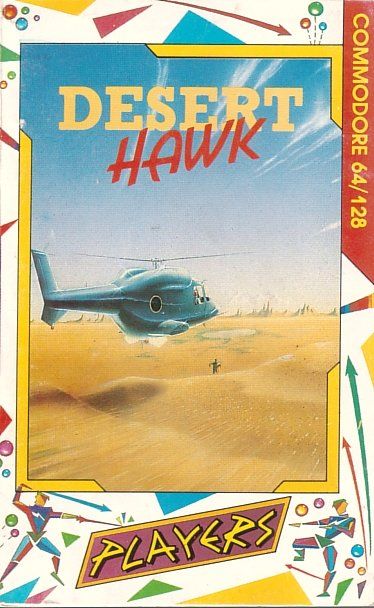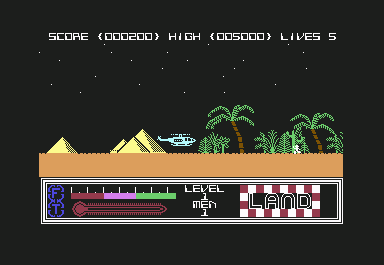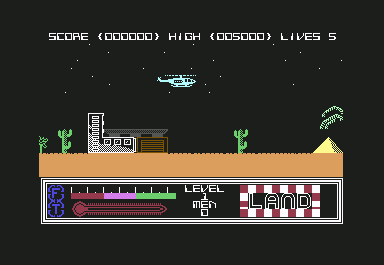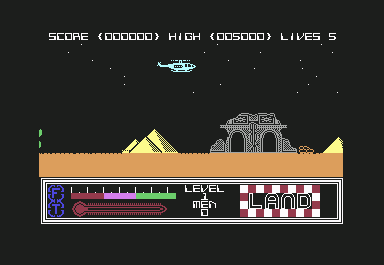Retro Replay Review
Gameplay
Desert Hawk delivers a tight, responsive 2D side-scrolling experience that feels instantly familiar to fans of classic shoot-’em-ups like Choplifter!. You pilot a military helicopter behind enemy lines, balancing aggressive combat with careful rescue operations. Controls are straightforward: throttle up, descend, strafe left and right, and fire your limited arsenal of missiles. This simplicity ensures that new players can jump in quickly, while tighter maneuvers and fuel-saving landings reward those who master the physics.
(HEY YOU!! We hope you enjoy! We try not to run ads. So basically, this is a very expensive hobby running this site. Please consider joining us for updates, forums, and more. Network w/ us to make some cash or friends while retro gaming, and you can win some free retro games for posting. Okay, carry on 👍)
The core loop of seeking out stranded comrades, landing in hostile territory, and then guiding them back to base injects a satisfying sense of purpose into each mission. Only three soldiers at a time can fit under your rotorcraft, so every trip becomes a mini strategy puzzle: scout safe landing zones (as indicated by the onboard computer), avoid enemy fire, and optimize your return route before fuel or missiles run out. When you’re down to single-digit fuel levels, every second feels critical, turning routine pickups into high-stakes gambles.
Enemy AI is surprisingly dynamic for a retro-styled shooter. Tanks patrol the ground with heavy cannons, fixed anti-aircraft guns pelt you with flak, and rogue fighters weave through the sky with heat-seeking missiles that demand constant vigilance. Rather than overwhelming you with sheer numbers, Desert Hawk spaces out engagements so you’re forced to juggle offense and defense—sometimes choosing between neutralizing a tank emplacement or pushing onward to rescue the last soldier before your fuel gauge hits zero.
Graphics
Visually, Desert Hawk embraces pixel-art charm without feeling archaic. The helicopter sprite is detailed, with rotors that blur convincingly at full speed, while damage flashes and smoke trails add extra polish. Terrain graphics shift from sandy dunes to rocky outcrops and makeshift enemy encampments, delivering variety across its levels. Subtle parallax scrolling in the background mountains imparts depth, ensuring the world never feels flat despite the 2D perspective.
Animation is smooth and purposeful: rockets arch realistically, rotor blades spin at varying speeds, and rescued comrades cling to the skids in a delightfully crude yet effective bit of sprite work. Explosions are chunky and satisfying, with debris puffing into the sky and craters left behind—a small touch that reinforces the impact of your strikes. Enemy aircraft roll and bank rather than snapping around, which not only looks better but also helps you anticipate incoming threats.
The color palette remains grounded in muted browns, dusty yellows, and olive drab, but occasional flashes of desert sunset or bright tracer fire keep scenes visually engaging. User-interface elements, such as your fuel and missile counters, are integrated neatly into the cockpit HUD, maintaining immersion. Though it doesn’t boast high-definition pomp, Desert Hawk proves that meticulous pixel art and clever use of motion can still deliver an eye-catching presentation.
Story
Desert Hawk’s narrative is lean but serviceable: a covert rescue mission deep behind enemy lines with high-value personnel awaiting extraction. Briefing screens set the stage with terse communiqués and mission objectives, giving each level a clear purpose without bogging the player down in cutscenes. The urgency of war comes through in radio chatter snippets between missions, highlighting the stakes without becoming intrusive.
Each rescued comrade feels earned, even if they don’t have individual names or backstories. The act of lifting them to safety carries genuine weight when you return to base and watch them file off the screen—gone but not forgotten. The game’s sparse narrative also leaves room for player imagination, allowing you to mentally flesh out the broader conflict and the lives you’re saving.
While there’s no sprawling plot twist or hidden lore to uncover, Desert Hawk’s story excels as a backdrop for intense, arcade-style action. Missions escalate in difficulty in a way that feels narrative-driven—you start in relatively calm desert outskirts, then gradually push into heavily fortified zones, culminating in near-suicidal runs under the enemy’s anti-air umbrella. For players seeking a lightweight storyline that propels you forward without shoehorning drama, it hits the mark.
Overall Experience
Desert Hawk strikes a satisfying balance between nostalgia and modern design sensibilities. Its blend of precise controls, strategic rescue objectives, and punishing yet fair enemy encounters creates a compelling loop that keeps you coming back for “just one more run.” The limited fuel and ammo constraints add a layer of resource management uncommon in shooters of this style, rewarding careful planning as much as quick reflexes.
Beyond pure gameplay, the game’s presentation—crisp pixel art, dynamic animations, and immersive HUD elements—cements its identity as a polished indie homage rather than a crude retro clone. Sound design, featuring throbbing rotor loops, distant explosions, and terse radio commands, rounds out the atmosphere nicely, making each take-off and landing feel weighty and consequential.
For potential buyers seeking an action-packed 2D aerial rescue shooter, Desert Hawk offers a robust package. Its concise levels are perfect for quick pick-up sessions, yet the escalating challenge and hidden skill ceilings ensure that experienced players will extract every ounce of fun. Whether you cut your teeth on classic ’80s shoot-’em-ups or are simply in search of a game that tests your nimble piloting and strategic mind, Desert Hawk warrants a spot on your watch list.
 Retro Replay Retro Replay gaming reviews, news, emulation, geek stuff and more!
Retro Replay Retro Replay gaming reviews, news, emulation, geek stuff and more!









Reviews
There are no reviews yet.